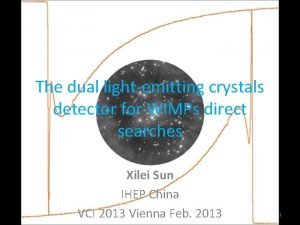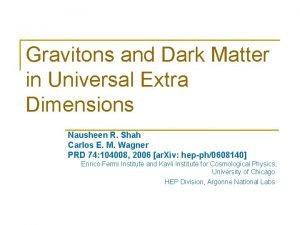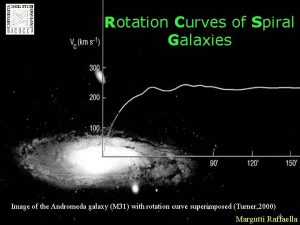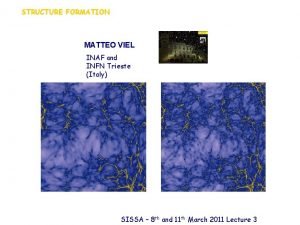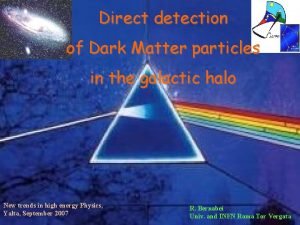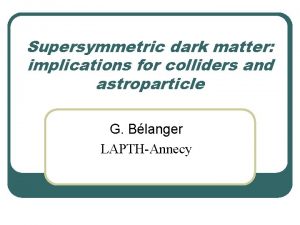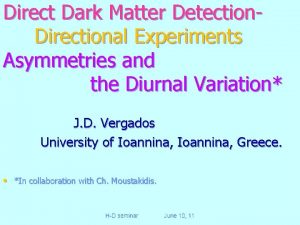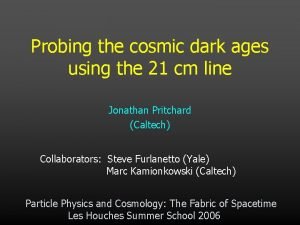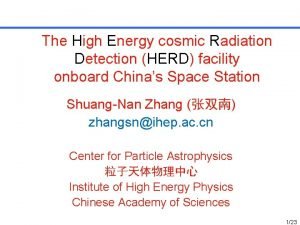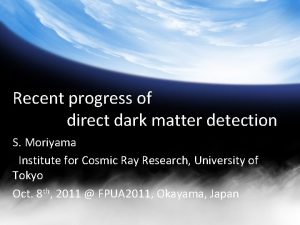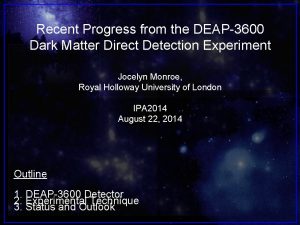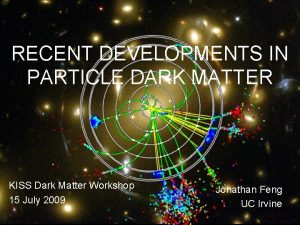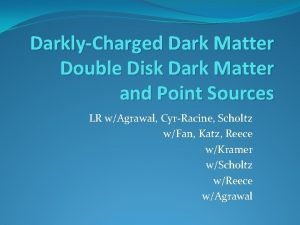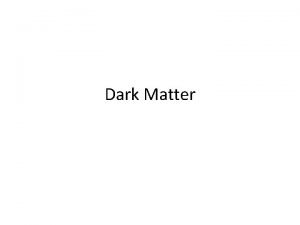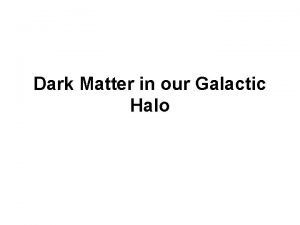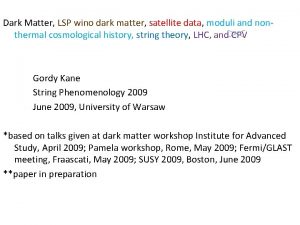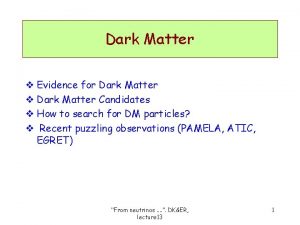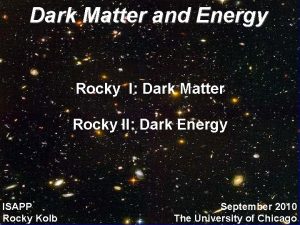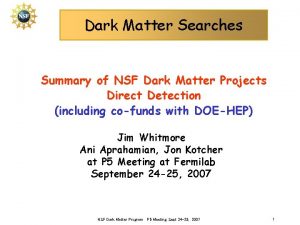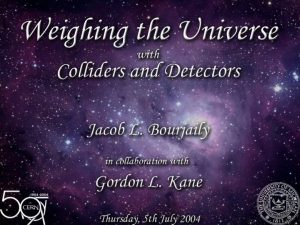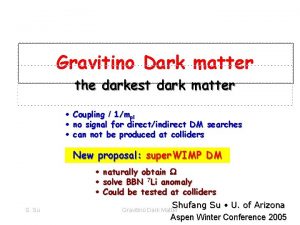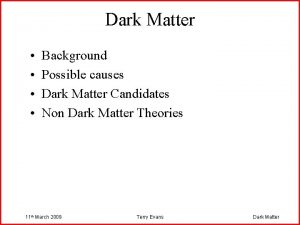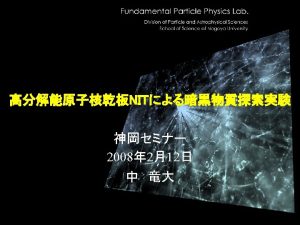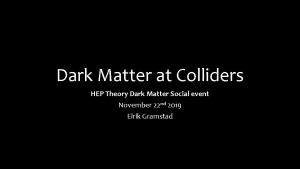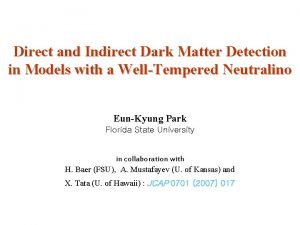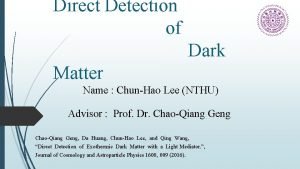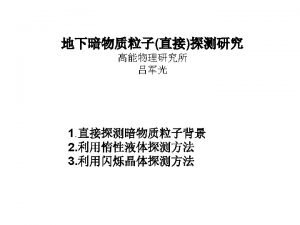Recent progress of direct dark matter detection S
































- Slides: 32

Recent progress of direct dark matter detection S. Moriyama Institute for Cosmic Ray Research, University of Tokyo Oct. 8 th, 2011 @ FPUA 2011, Okayama, Japan

Principle of direct detection in Lab. Ordinary matter Scattering Dark matter Annihilation Ordinary matter Comoving number density • Dark matter hit detectors in Lab. Why interaction expected? • Assume DM particles were thermally generated. • They annihilated into ordinary matter. This implies an interaction between dark matter and ordinary matter (atoms). • Weakly Interacting Massive Particles (WIMPs) 1/temperature ~ time

How much dark matter around us? • It can be estimated by measuring rotational curve of the galaxy. Local density ~ 0. 3 Ge. V/cc ~average x 105 • Isothermal, Maxwell distribution (<v> ~230 km/s, <b>~10 -3). R. P. Olling and M. R. Merrifield MNRAS 311, 369 - (2000) Dark Halo Steller disk Buldge • These dark matter particles are expected to cause nuclear recoils even in underground lab.

Signals after nuclear recoils • Small energy depositions (mp <v>2/2 < 1 ke. V), rare. • Scintillation light (photons), ionizations, phonons, etc are expected to be observed. • By combining multi. info. , BG reduction is possible. - - + ++ Scintillation lights Phonon signals Ionization. . . signals Bubble generation

Expected energy spectrum of nuclear recoil, ~O(10 ke. V) Xe Ge Si Si Red: differential, Blue: integrated R. J. Gaitskell, Ann. Rev. Part. Sci. , 54 (2004) 315. • Coherent interaction with each nucleon in nuclei causes enhancement. • Target nuclei with similar mass to DM is the best choice.

Another aspect: annual modulation • Due to a peculiar motion of the solar system inside the galaxy, relative velocity to the rest frame of dark matter varies over a sidereal year. • This causes the modulation of event rates and energy spectrum.

Unknown: mass and cross section! cross section to nucleon UNKNOWN Detector with smaller atomic number and low energy threshold Detector with larger mass, longer exposure and lower background True parameter Mass of dark matter particle UNKNOWN • Small mass: low energy threshold detector with light nucleus ~O(Ge. V/c 2) • Small cross section: massive and low BG detector ~O(1/day/ton) 3 orders/15 years!

Experiments all over the world >30! DAMA/LIBRA XENON CRESSTII EDELWEISS ZEPLIN DRIFT WARP Ar. DM ANAIS MIMAC ROSEBUD KIMS PANDAX CDEX TEXONO XMASS NEWAGE PICO-LON NIT PICASSO CDMS Co. Ge. NT COUPP DEAP/CLEAN SIMPLE DMTPC LUX Strong tension exists among experiments. DAMA, Co. Ge. NT, CRESSTII XENON, CDMS DM-Ice Not complete

1. DAMA/Na. I Antonella, TAUP 2011 (7 yr), DAMA/LIBRA (6 yr), 430 td

Positive signal of annual modulation • Radioactive pure Na. I(Tl): scintillation only, no PID. • Strong signature of the annual modulation, ~9 s Modulation of +/-2% by Sep. 2009 • A lot of criticisms at the beginning, but later serious study/consideration started (light DM, IDM, etc. ). • Influences of seasonal modulating cosmic muons? An unnatural background shape is in doubt.

Science 332 (2011) 1144 PRL 101, 251301 (2008) 2. Co. Ge. NT (Ge) 140 kgd • P-type point contact detector has very low noise thus low energy threshold due to small cap. smaller-mass DM w/ ionization only ar. Xi. V 1106. 06500

Assume all the unknown events from DM Mod. (c 2/dof=7. 8/12) 80%C. L. accept. Flat (c 2/dof=20. 3/15) 84% C. L. reject. Is the contamination of surface modulation is favored with background well controlled? ? 99. 4% C. L.

3. XENON 100, 4. 8 td Rafael, TAUP 2011 • Particle ID possible • BG red.

Observed data and calibration Nuclear recoil e/gamma Observed data Neutron source (causes nuclear recoil) calibration data 99. 75% rejection line and 3 sigma contour of NR DM search window (8. 4 -44. 6 ke. Vnr) • 3 events remained • 1. 8+/-0. 6 BG expected (28%)

Status of dark matter search Co. Ge. NT (Ge)90% 5 -7 Ge. V DAMA, Na, 3 s DAMA, I, 3 s CRESST 2 s CDMS (Ge) XENON 100 (Xe) O. Buchmueller et al. CMSSM (68%, 95%) ar. Xiv: 1106. 2529 Including 2010 LHC +CDMS(LE), XENON 10(LE) • 3 orders of sensitivity improved over last 15 years!

Recent “signals” of DM, axion, and n • 2000: DAMA experiment (Gran Sasso) started to claim the observation of dark matter. • 2005: PVLAS collaboration (INFN) axions? • 2010/2011: Co. Ge. NT (Soudan, US) • 2011: CRESST II (Gran Sasso) • 2011: OPERA (Gran Sasso, CERN) observation of super-luminal neutrinos

“Italian signals” Recent “signals” of DM, axion, and n • 2000: DAMA experiment (Gran Sasso) started to claim the observation of dark matter. >8 s now ry a s s e c e n k c e h • 2005: PVLAS collaboration (INFN) axions? withdrawn c l r e exp a t n e m i r • 2010/2011: Co. Ge. NT (Soudan, US) e h t r u F • 2011: CRESST II (Gran Sasso) • 2011: OPERA (Gran Sasso, CERN) observation of super-luminal neutrinos

XMASS experiment

The XMASS collaborations Kamioka Observatory, ICRR, Univ. of Tokyo: Y. Suzuki, M. Nakahata, S. Moriyama, M. Yamashita, Y. Kishimoto, Y. Koshio, A. Takeda, K. Abe, H. Sekiya, H. Ogawa, K. Kobayashi, K. Hiraide, A. Shinozaki, S. Hirano, D. Umemoto, O. Takachio, K. Hieda IPMU, University of Tokyo: K. Martens, J. Liu Kobe University: Y. Takeuchi, K. Otsuka, K. Hosokawa, A. Murata Tokai University: K. Nishijima, D. Motoki, F. Kusaba Gifu University: S. Tasaka Yokohama National University: S. Nakamura, I. Murayama, K. Fujii Miyagi University of Education: Y. Fukuda STEL, Nagoya University: Y. Itow, K. Masuda, H. Uchida, Y. Nishitani, H. Takiya Sejong University: Y. D. Kim 41 collaborators, KRISS: Y. H. Kim, M. K. Lee, K. B. Lee, J. S. Lee 10 institutes

Kamioka Observatory • 1000 m under a mountain = 2700 m water equiv. • 360 m above the sea • Low cosmic ray flux (10 -5) • Horizontal access • Super-K for n physics and other experiments in deep underground • Kam. LAND (Tohoku U. ) By courtesy of Dr. Miyoki

XMASS experiment ●XMASS ◎ Xenon MASSive detector for Solar neutrino (pp/7 Be) ◎ Xenon neutrino MASS detector (double beta decay) ◎ Xenon detector for Weakly Interacting MASSive Particles (DM search) • It was proposed that 10 ton FV (24 ton) 2. 5 m 100 kg FV (800 kg) 0. 8 m, DM Liquid xenon was a Solar n, 0 nbb, DM First phase good candidate to in future satisfy scalability and low background. Y. Suzuki, hep-ph/0008296 • As the first phase, an 800 kg detector for a dark matter search was constructed.

Structure of the 800 kg detector • Single phase liquid Xenon (-100 o. C, ~0. 065 MPa) scintillator – 835 kg of liquid xenon, 100 kg in the fiducial volume – 642 PMTs – 5 ke. Velectron equiv. (~25 ke. Vnuclear recoil) thre.

Attenuation length (cm) BG reduction by self shielding effect 10 cm 1 cm Photo Electric Effect Compton effect water LXe ~O(500 ke. V) E (ke. V) • Photo electric effect starts to dominate @500 ke. V: strong self shielding effect is expected for low energy radiations.

Event reconstruction

Demonstration of the detector performance • Calibration system – Introduction of radioactive sources into the detector. – <1 mm accuracy along the Z axis. – Thin wire source for some low energy g rays to avoid shadowing effect. – 57 Co, 241 Am, 109 Cd, 55 Fe, 137 Cs. . Stepping Motor Linear Motion Feedthrough ~5 m Source rod with a dummy source 0. 15 mmf for 57 Co source 4 mmf Top photo tube Gate valve

High light yield and good position resolution 57 Co Reconstructed energy DATA MC 122 ke. V +15 V ~4% rms 59. 3 ke. V (W-Ka) 136 ke. V [ke. V] Data at various positions source at the center shows a typical response of the detector. High p. e. yield 16. 0+/-1. 0 p. e. /ke. V was obtained. Factor 3 higher than expected. • The photo electron yield distribution was reproduced by a simulation well. • Good position res. ~1 cm obtained. •

Expected background Background in unit mass Very low BG at low energy Major background must come from radioactivity in PMTs though we developed low BG PMTs. Radioactive impurity inside liquid xenon also must be low: 85 Kr distillation Rn charcoal BG ~ 10 -4 /kg/ke. V/day is expected to be realized. (XENON 100 ~0. 5 x 10 -4/kg/ke. V/day)

Expected sensitivity Spin Independent SII M CD 00 N 1 NO XE Initial target of the energy threshold was ~5 ke. Vee. Because we have factor ~3 better photoelectron yield, lower threshold = smaller mass dark matter may be looked for. 0 d 0 1. e r e th e V e k 5 Expected energy spec. XMASS 2 k S S A M X 0 d 0 1. e r e. Vee th 1 year exposure scp=10 -44 cm 2 50 Ge. V WIMP Black: signal+BG Red: BG

Assembly of PMT holder and installation of PMTs

Joining two halves


Summary • “Positive” signals by DAMA, Co. Ge. NT, and CRESST-II (~10 Ge. V, 10 -40 cm 2) are around the detector threshold where our knowledge on the detector systematic and background are not established. Further experimental confirmations are necessary, and on going. • The XMASS 800 kg detector aims to detect dark matter with the sensitivity 2 x 10 -45 cm 2 (spin independent case) with LXe. • Commissioning runs are on going to confirm the detector performance and low background properties. – Energy resolution and vertex resolution were as expected. ~1 cm position resolution and ~4% energy resolution for 122 ke. V g.
 Dark matter and dark energy ppt
Dark matter and dark energy ppt Recent developments in object detection
Recent developments in object detection Physical progress and financial progress
Physical progress and financial progress In a dark dark town
In a dark dark town Dark matter
Dark matter Dark matter old gravitons dimensions
Dark matter old gravitons dimensions Dark matter physics
Dark matter physics Dark matter
Dark matter Boosted dark matter
Boosted dark matter Where to stream dark matter
Where to stream dark matter Dark matter
Dark matter Dark matter
Dark matter What could dark matter be
What could dark matter be Les houches dark matter
Les houches dark matter Calo
Calo Primary taste cortex
Primary taste cortex Energy naturally flows from warmer matter to cooler matter.
Energy naturally flows from warmer matter to cooler matter. Grey matter nervous system
Grey matter nervous system Composition of matter section 1
Composition of matter section 1 Composition of matter section 1
Composition of matter section 1 Gray matter and white matter
Gray matter and white matter Chapter 2 section 1 classifying matter answers
Chapter 2 section 1 classifying matter answers What is gray matter in the brain
What is gray matter in the brain Section 1 composition of matter
Section 1 composition of matter Https drive google com drive u 0 recent
Https drive google com drive u 0 recent In a recent car accident tamiko
In a recent car accident tamiko Https://drive.google.com/drive/
Https://drive.google.com/drive/ Explain recent trends in india's foreign trade
Explain recent trends in india's foreign trade Recent demographic changes in the uk
Recent demographic changes in the uk A friend emails you the results
A friend emails you the results Recent trends in ic engine
Recent trends in ic engine Recent amendments in companies act
Recent amendments in companies act Importance of scanning and skimming
Importance of scanning and skimming




